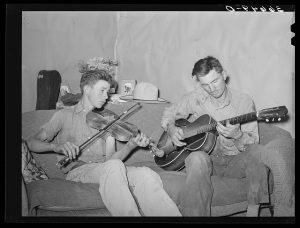
Library of Congress Photos & Print Division. 1940. Farmer and His Brother Making Music. Pie Town, New Mexico.
Do songs have a purpose? I think they do. Think about the music that you listen to on the
way to work, while you’re doing your homework, sometimes while you sleep. Many songs serve a purpose in today’s culture in America, I think working songs in the 19th century aren’t much different. One song that comes to mind is Songs of the Sea, they serve as a beacon of unity and tribute to the voyage. See below an article written for an American music magazine, an interview of men who sail frequently. Check out this link below for the interview.
We see another aspect of working songs in Negro spirituals, most sung by enslaved people while working in the 19th century.2 These songs serve as a beacon of hope and spirituality for them while being forced to work. These spirituals are deeply rooted in Christian traditions, religion can be an out-of-body experience that brings communities together. They all have their religion in common and it can bring them together. “In Africa, music had been central to people’s lives: Music-making permeated important life events and daily activities. However, the white colonists of North America were alarmed by and frowned upon the slaves’ African-infused way of worship because they considered it to be idolatrous and wild.”3 This quote from an article cataloged by the Library of Congress displays the sense of community that these spirituals bring. Before the atrocities committed against the African people, they had music as an integral part of their lives, and no oppression from the white man was going to stop them from making their community out of music. They might be wearing a different set of clothes, but still very important to their community and culture.
Another example of working songs that bring a community together are songs sung by the working class in the 19th century. Popular songs like the “Bell Hop Blues” and “All in, down and out” perfectly demonstrate the songs of the working class.4 The Bell Hop Blues is a song about a bellhop and how he laments his position in the world. Feeling like he can go nowhere the bellhop sings about it, the song below is sung by Al Bernard. As someone who must work hard to stay afloat, I resonate with this song. I feel like many would have resonated as well when the song was popular.
I found through my research that the songs of the working class serve as a sense of unity for us. As the underdogs in a money-driven society, we find ways for our community to prosper and grow. Music serves as a catalyst for this.
1“SONGS OF THE SEA.” The Musical Visitor, a Magazine of Musical Literature and Music (1883-1897), 02, 1884, 31, https://www.proquest.com/magazines/songs-sea/docview/137456031/se-2.
2Magazine, Smithsonian, and Lincoln Mullen. 2014. “These Maps Reveal How Slavery Expanded across the United States.” Smithsonian Magazine. May 14, 2014. https://www.smithsonianmag.com/history/maps-reveal-slavery-expanded-across-united-states-180951452/#:~:text=In%20counties%20along%20the%20Atlantic.
3Library of Congress. 2015. “African American Spirituals.” The Library of Congress. 2015. https://www.loc.gov/item/ihas.200197495/.
4———. n.d. “Songs of Work and Industry | Historical Topics | Articles and Essays | the Library of Congress Celebrates the Songs of America | Digital Collections | Library of Congress.” Library of Congress, Washington, D.C. 20540 USA. https://www.loc.gov/collections/songs-of-america/articles-and-essays/historical-topics/songs-of-work-and-industry/.
5Bourdon, Rosario, Al Bernard, Frank Goodman, and Al Piantadosi. Bell Hop Blues. 1919. Audio. https://www.loc.gov/item/jukebox-33747/.
Citations:
Bourdon, Rosario, Al Bernard, Frank Goodman, and Al Piantadosi. Bell Hop Blues. 1919. Audio. https://www.loc.gov/item/jukebox-33747/.
Chase, Randall. “Negro Spirituals an Enduring Legacy.” Sunday Gazette – Mail, May 15, 2005. https://www.proquest.com/newspapers/negro-spirituals-enduring-legacy/docview/332335829/se-2.
Library of Congress. 2015. “African American Spirituals.” The Library of Congress. 2015. https://www.loc.gov/item/ihas.200197495/.Library of Congress Photos & Print Division. 1940. Farmer and His Brother Making Music. Pie Town, New Mexico.
———. n.d. “Songs of Work and Industry | Historical Topics | Articles and Essays | the Library of Congress Celebrates the Songs of America | Digital Collections | Library of Congress.” Library of Congress, Washington, D.C. 20540 USA. https://www.loc.gov/collections/songs-of-america/articles-and-essays/historical-topics/songs-of-work-and-industry/.
